Advanced Asset Management and Reliability Centered Maintenance
VerifiedAdded on 2022/12/23
|6
|1208
|41
Report
AI Summary
This report delves into the principles and practices of Reliability Centered Maintenance (RCM) within the context of advanced asset management. It begins by outlining the evolution of maintenance strategies, emphasizing the shift towards condition-based and predictive maintenance approaches, and contrasting them with traditional preventive methods. The report defines RCM, highlighting its focus on preserving system functions and preventing failures. It breaks down the methodology of RCM into key features, including function preservation, failure mode identification, prioritization, and task selection. The report also discusses alternative approaches like Risk-CM and the application of Pareto's 80-20 principle for efficient resource allocation. It emphasizes the importance of integrating RCM with other methodologies and concludes by underscoring the significance of effectively communicating the RCM concept within an organization. The report includes a comprehensive list of references supporting the analysis.
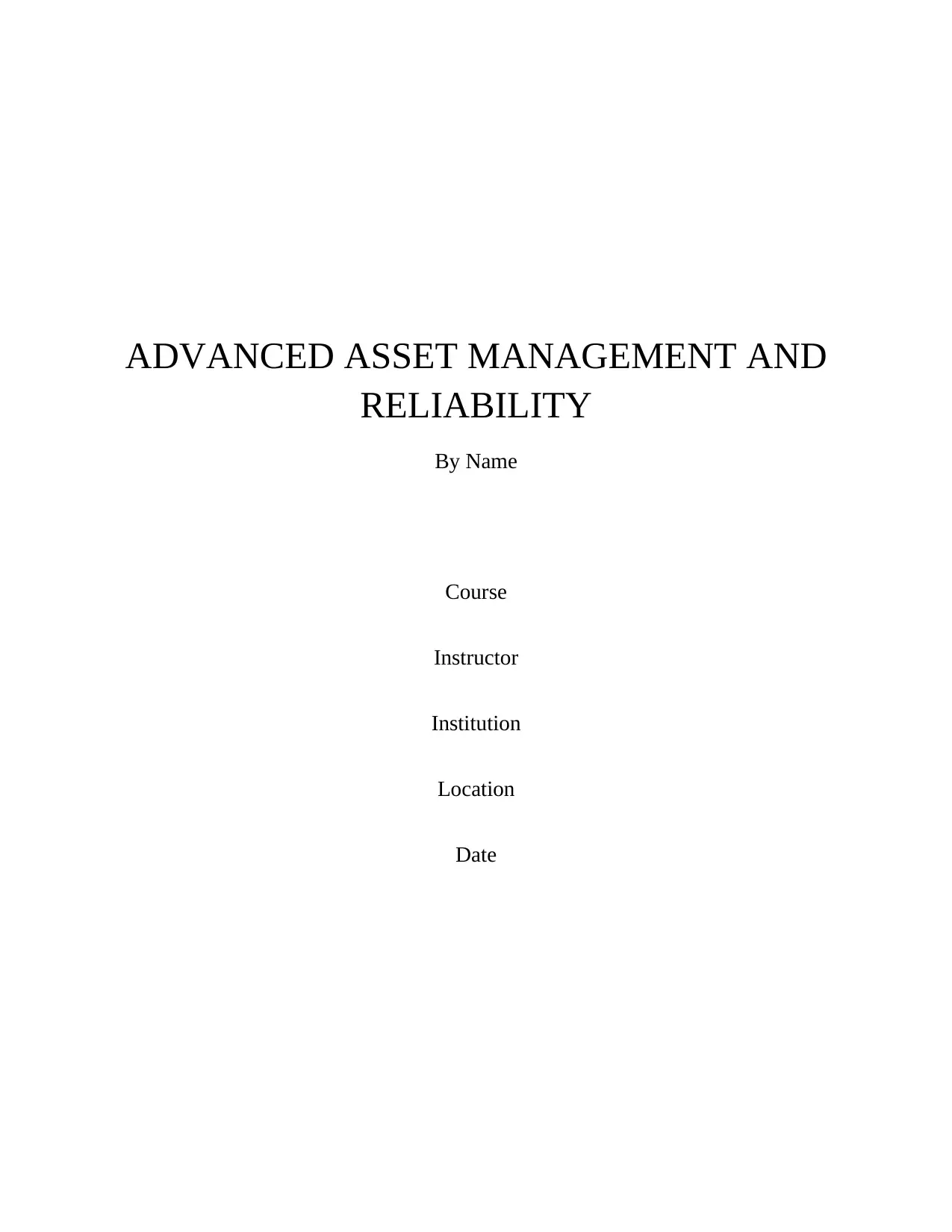
ADVANCED ASSET MANAGEMENT AND
RELIABILITY
By Name
Course
Instructor
Institution
Location
Date
RELIABILITY
By Name
Course
Instructor
Institution
Location
Date
Paraphrase This Document
Need a fresh take? Get an instant paraphrase of this document with our AI Paraphraser
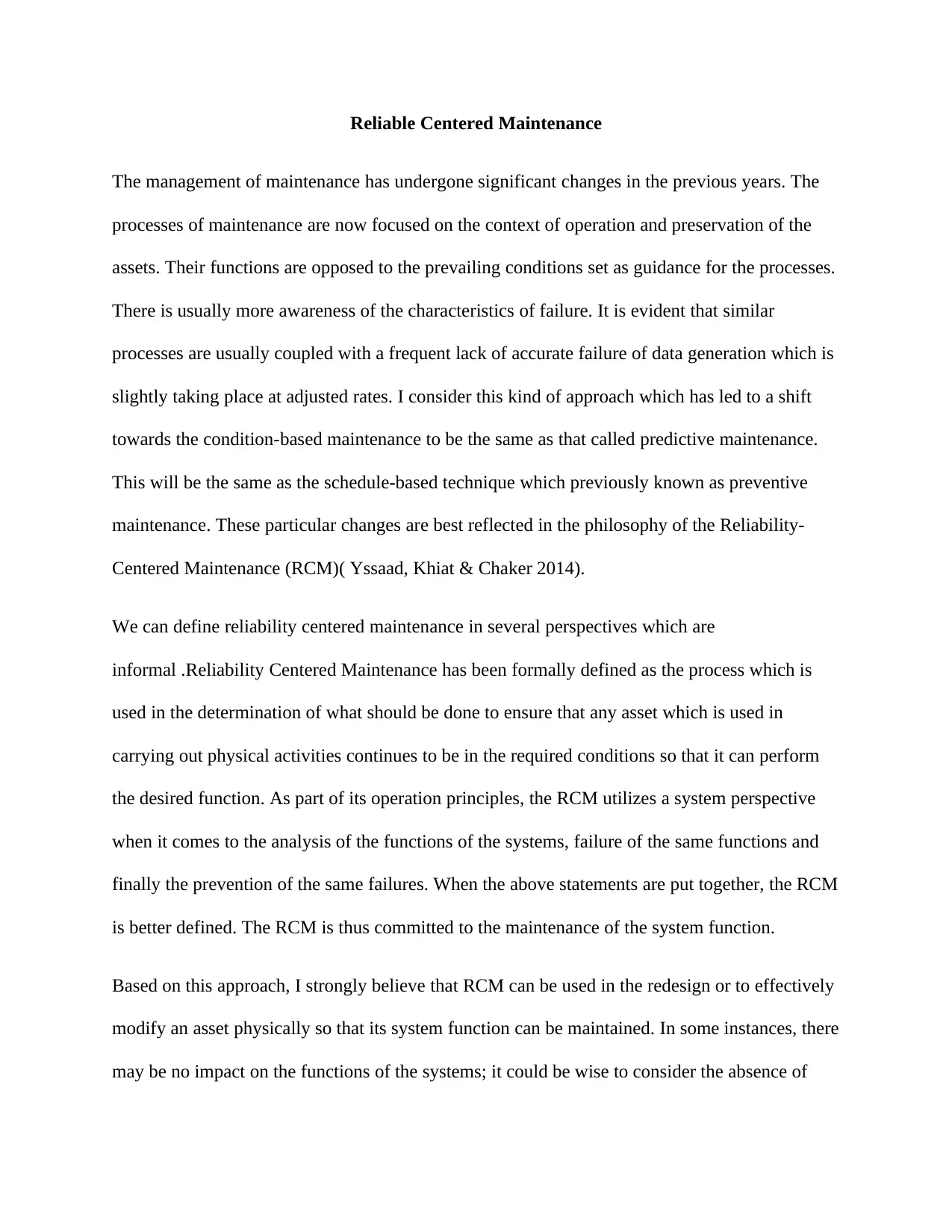
Reliable Centered Maintenance
The management of maintenance has undergone significant changes in the previous years. The
processes of maintenance are now focused on the context of operation and preservation of the
assets. Their functions are opposed to the prevailing conditions set as guidance for the processes.
There is usually more awareness of the characteristics of failure. It is evident that similar
processes are usually coupled with a frequent lack of accurate failure of data generation which is
slightly taking place at adjusted rates. I consider this kind of approach which has led to a shift
towards the condition-based maintenance to be the same as that called predictive maintenance.
This will be the same as the schedule-based technique which previously known as preventive
maintenance. These particular changes are best reflected in the philosophy of the Reliability-
Centered Maintenance (RCM)( Yssaad, Khiat & Chaker 2014).
We can define reliability centered maintenance in several perspectives which are
informal .Reliability Centered Maintenance has been formally defined as the process which is
used in the determination of what should be done to ensure that any asset which is used in
carrying out physical activities continues to be in the required conditions so that it can perform
the desired function. As part of its operation principles, the RCM utilizes a system perspective
when it comes to the analysis of the functions of the systems, failure of the same functions and
finally the prevention of the same failures. When the above statements are put together, the RCM
is better defined. The RCM is thus committed to the maintenance of the system function.
Based on this approach, I strongly believe that RCM can be used in the redesign or to effectively
modify an asset physically so that its system function can be maintained. In some instances, there
may be no impact on the functions of the systems; it could be wise to consider the absence of
The management of maintenance has undergone significant changes in the previous years. The
processes of maintenance are now focused on the context of operation and preservation of the
assets. Their functions are opposed to the prevailing conditions set as guidance for the processes.
There is usually more awareness of the characteristics of failure. It is evident that similar
processes are usually coupled with a frequent lack of accurate failure of data generation which is
slightly taking place at adjusted rates. I consider this kind of approach which has led to a shift
towards the condition-based maintenance to be the same as that called predictive maintenance.
This will be the same as the schedule-based technique which previously known as preventive
maintenance. These particular changes are best reflected in the philosophy of the Reliability-
Centered Maintenance (RCM)( Yssaad, Khiat & Chaker 2014).
We can define reliability centered maintenance in several perspectives which are
informal .Reliability Centered Maintenance has been formally defined as the process which is
used in the determination of what should be done to ensure that any asset which is used in
carrying out physical activities continues to be in the required conditions so that it can perform
the desired function. As part of its operation principles, the RCM utilizes a system perspective
when it comes to the analysis of the functions of the systems, failure of the same functions and
finally the prevention of the same failures. When the above statements are put together, the RCM
is better defined. The RCM is thus committed to the maintenance of the system function.
Based on this approach, I strongly believe that RCM can be used in the redesign or to effectively
modify an asset physically so that its system function can be maintained. In some instances, there
may be no impact on the functions of the systems; it could be wise to consider the absence of
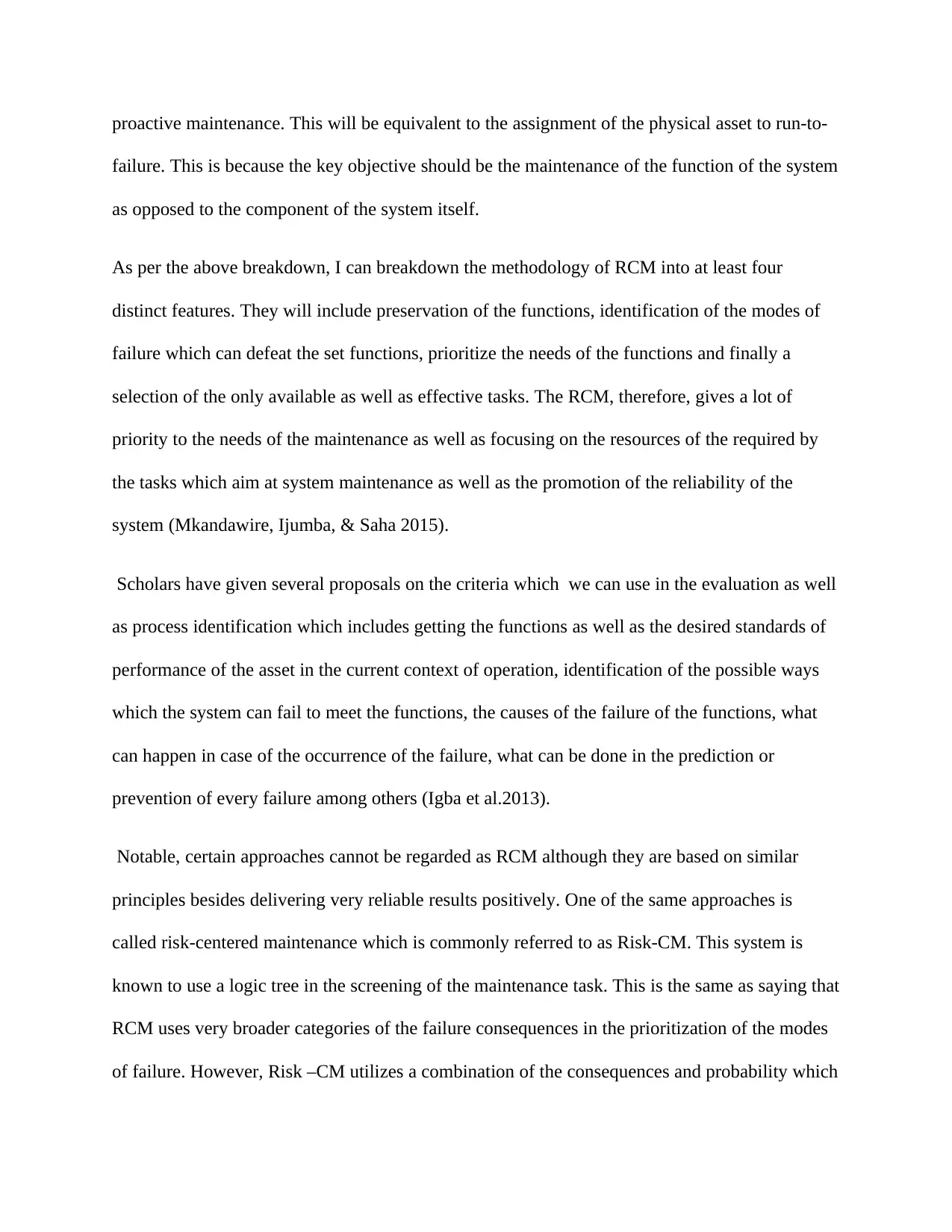
proactive maintenance. This will be equivalent to the assignment of the physical asset to run-to-
failure. This is because the key objective should be the maintenance of the function of the system
as opposed to the component of the system itself.
As per the above breakdown, I can breakdown the methodology of RCM into at least four
distinct features. They will include preservation of the functions, identification of the modes of
failure which can defeat the set functions, prioritize the needs of the functions and finally a
selection of the only available as well as effective tasks. The RCM, therefore, gives a lot of
priority to the needs of the maintenance as well as focusing on the resources of the required by
the tasks which aim at system maintenance as well as the promotion of the reliability of the
system (Mkandawire, Ijumba, & Saha 2015).
Scholars have given several proposals on the criteria which we can use in the evaluation as well
as process identification which includes getting the functions as well as the desired standards of
performance of the asset in the current context of operation, identification of the possible ways
which the system can fail to meet the functions, the causes of the failure of the functions, what
can happen in case of the occurrence of the failure, what can be done in the prediction or
prevention of every failure among others (Igba et al.2013).
Notable, certain approaches cannot be regarded as RCM although they are based on similar
principles besides delivering very reliable results positively. One of the same approaches is
called risk-centered maintenance which is commonly referred to as Risk-CM. This system is
known to use a logic tree in the screening of the maintenance task. This is the same as saying that
RCM uses very broader categories of the failure consequences in the prioritization of the modes
of failure. However, Risk –CM utilizes a combination of the consequences and probability which
failure. This is because the key objective should be the maintenance of the function of the system
as opposed to the component of the system itself.
As per the above breakdown, I can breakdown the methodology of RCM into at least four
distinct features. They will include preservation of the functions, identification of the modes of
failure which can defeat the set functions, prioritize the needs of the functions and finally a
selection of the only available as well as effective tasks. The RCM, therefore, gives a lot of
priority to the needs of the maintenance as well as focusing on the resources of the required by
the tasks which aim at system maintenance as well as the promotion of the reliability of the
system (Mkandawire, Ijumba, & Saha 2015).
Scholars have given several proposals on the criteria which we can use in the evaluation as well
as process identification which includes getting the functions as well as the desired standards of
performance of the asset in the current context of operation, identification of the possible ways
which the system can fail to meet the functions, the causes of the failure of the functions, what
can happen in case of the occurrence of the failure, what can be done in the prediction or
prevention of every failure among others (Igba et al.2013).
Notable, certain approaches cannot be regarded as RCM although they are based on similar
principles besides delivering very reliable results positively. One of the same approaches is
called risk-centered maintenance which is commonly referred to as Risk-CM. This system is
known to use a logic tree in the screening of the maintenance task. This is the same as saying that
RCM uses very broader categories of the failure consequences in the prioritization of the modes
of failure. However, Risk –CM utilizes a combination of the consequences and probability which
⊘ This is a preview!⊘
Do you want full access?
Subscribe today to unlock all pages.

Trusted by 1+ million students worldwide
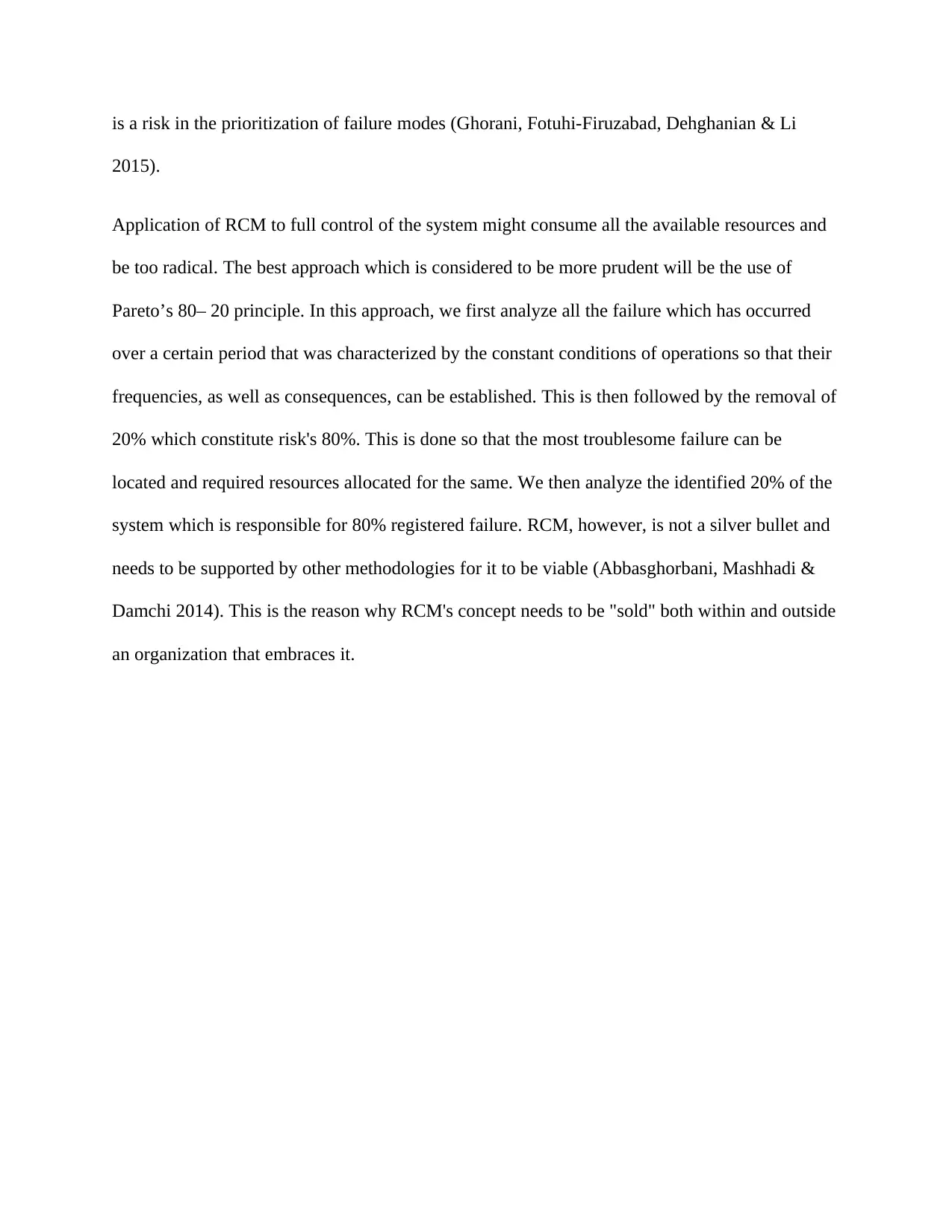
is a risk in the prioritization of failure modes (Ghorani, Fotuhi-Firuzabad, Dehghanian & Li
2015).
Application of RCM to full control of the system might consume all the available resources and
be too radical. The best approach which is considered to be more prudent will be the use of
Pareto’s 80– 20 principle. In this approach, we first analyze all the failure which has occurred
over a certain period that was characterized by the constant conditions of operations so that their
frequencies, as well as consequences, can be established. This is then followed by the removal of
20% which constitute risk's 80%. This is done so that the most troublesome failure can be
located and required resources allocated for the same. We then analyze the identified 20% of the
system which is responsible for 80% registered failure. RCM, however, is not a silver bullet and
needs to be supported by other methodologies for it to be viable (Abbasghorbani, Mashhadi &
Damchi 2014). This is the reason why RCM's concept needs to be "sold" both within and outside
an organization that embraces it.
2015).
Application of RCM to full control of the system might consume all the available resources and
be too radical. The best approach which is considered to be more prudent will be the use of
Pareto’s 80– 20 principle. In this approach, we first analyze all the failure which has occurred
over a certain period that was characterized by the constant conditions of operations so that their
frequencies, as well as consequences, can be established. This is then followed by the removal of
20% which constitute risk's 80%. This is done so that the most troublesome failure can be
located and required resources allocated for the same. We then analyze the identified 20% of the
system which is responsible for 80% registered failure. RCM, however, is not a silver bullet and
needs to be supported by other methodologies for it to be viable (Abbasghorbani, Mashhadi &
Damchi 2014). This is the reason why RCM's concept needs to be "sold" both within and outside
an organization that embraces it.
Paraphrase This Document
Need a fresh take? Get an instant paraphrase of this document with our AI Paraphraser
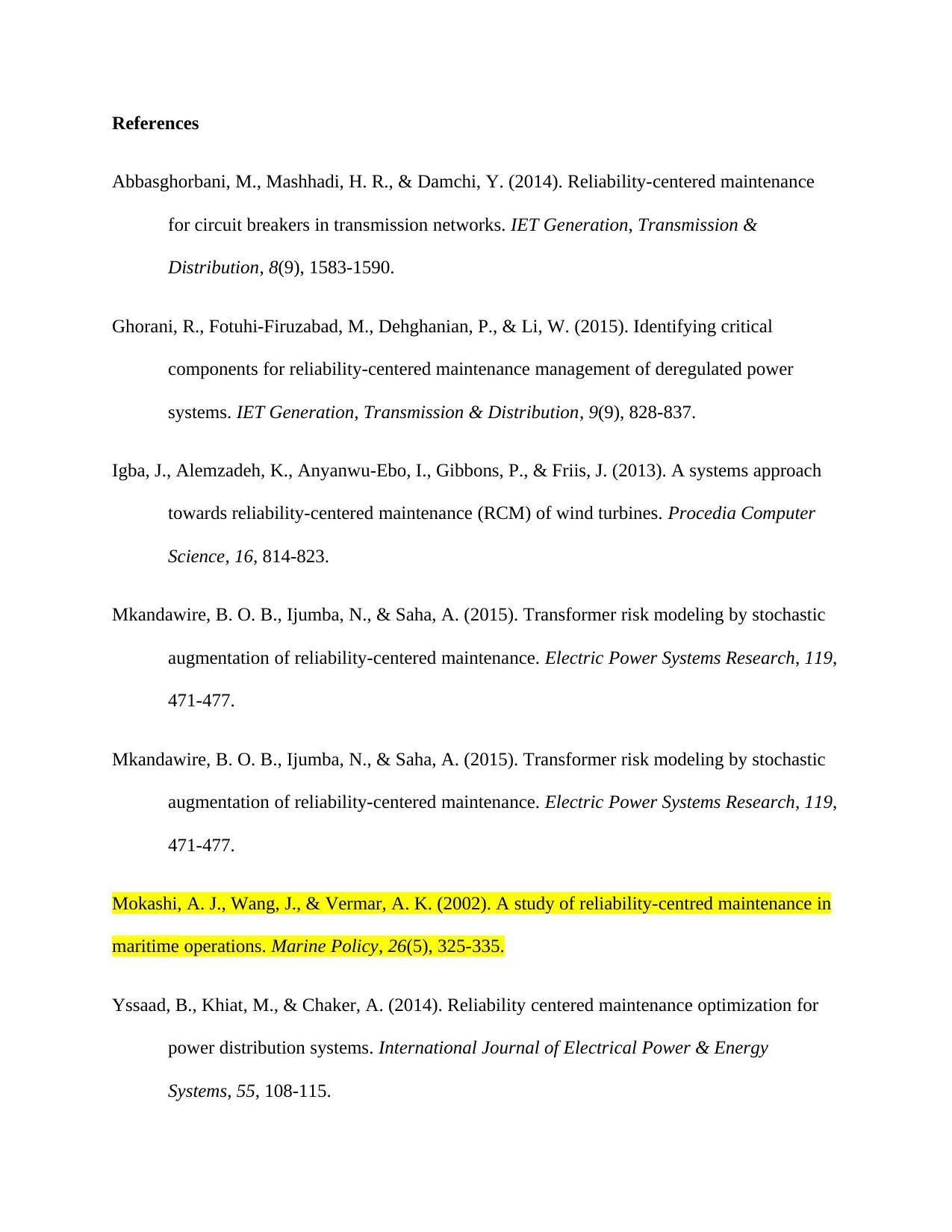
References
Abbasghorbani, M., Mashhadi, H. R., & Damchi, Y. (2014). Reliability-centered maintenance
for circuit breakers in transmission networks. IET Generation, Transmission &
Distribution, 8(9), 1583-1590.
Ghorani, R., Fotuhi-Firuzabad, M., Dehghanian, P., & Li, W. (2015). Identifying critical
components for reliability-centered maintenance management of deregulated power
systems. IET Generation, Transmission & Distribution, 9(9), 828-837.
Igba, J., Alemzadeh, K., Anyanwu-Ebo, I., Gibbons, P., & Friis, J. (2013). A systems approach
towards reliability-centered maintenance (RCM) of wind turbines. Procedia Computer
Science, 16, 814-823.
Mkandawire, B. O. B., Ijumba, N., & Saha, A. (2015). Transformer risk modeling by stochastic
augmentation of reliability-centered maintenance. Electric Power Systems Research, 119,
471-477.
Mkandawire, B. O. B., Ijumba, N., & Saha, A. (2015). Transformer risk modeling by stochastic
augmentation of reliability-centered maintenance. Electric Power Systems Research, 119,
471-477.
Mokashi, A. J., Wang, J., & Vermar, A. K. (2002). A study of reliability-centred maintenance in
maritime operations. Marine Policy, 26(5), 325-335.
Yssaad, B., Khiat, M., & Chaker, A. (2014). Reliability centered maintenance optimization for
power distribution systems. International Journal of Electrical Power & Energy
Systems, 55, 108-115.
Abbasghorbani, M., Mashhadi, H. R., & Damchi, Y. (2014). Reliability-centered maintenance
for circuit breakers in transmission networks. IET Generation, Transmission &
Distribution, 8(9), 1583-1590.
Ghorani, R., Fotuhi-Firuzabad, M., Dehghanian, P., & Li, W. (2015). Identifying critical
components for reliability-centered maintenance management of deregulated power
systems. IET Generation, Transmission & Distribution, 9(9), 828-837.
Igba, J., Alemzadeh, K., Anyanwu-Ebo, I., Gibbons, P., & Friis, J. (2013). A systems approach
towards reliability-centered maintenance (RCM) of wind turbines. Procedia Computer
Science, 16, 814-823.
Mkandawire, B. O. B., Ijumba, N., & Saha, A. (2015). Transformer risk modeling by stochastic
augmentation of reliability-centered maintenance. Electric Power Systems Research, 119,
471-477.
Mkandawire, B. O. B., Ijumba, N., & Saha, A. (2015). Transformer risk modeling by stochastic
augmentation of reliability-centered maintenance. Electric Power Systems Research, 119,
471-477.
Mokashi, A. J., Wang, J., & Vermar, A. K. (2002). A study of reliability-centred maintenance in
maritime operations. Marine Policy, 26(5), 325-335.
Yssaad, B., Khiat, M., & Chaker, A. (2014). Reliability centered maintenance optimization for
power distribution systems. International Journal of Electrical Power & Energy
Systems, 55, 108-115.

⊘ This is a preview!⊘
Do you want full access?
Subscribe today to unlock all pages.

Trusted by 1+ million students worldwide
1 out of 6
Related Documents
Your All-in-One AI-Powered Toolkit for Academic Success.
+13062052269
info@desklib.com
Available 24*7 on WhatsApp / Email
![[object Object]](/_next/static/media/star-bottom.7253800d.svg)
Unlock your academic potential
Copyright © 2020–2025 A2Z Services. All Rights Reserved. Developed and managed by ZUCOL.





